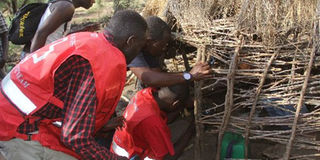Cocktail of scarcity, weapons and culture has stoked killings

Red Cross staff, journalists and villagers look at the body of one of the victims of Monday’s massacre in Nadome village in Turkana County. Police had earlier said they had not found bodies at the scene of the attack. PHOTO | JARED NYATAYA | NATION MEDIA GROUP
What you need to know:
- These have been made worse by cultural beliefs, poor education and the easy availability of sophisticated firearms which replaced the bows, arrows and spears that were used in the early 1970s.
- The increasing number of fatalities — with the attacks in Kapedo and Nadome being the latest — are a pointer that the new wave of violence could be resulting from disputed administrative boundaries.
- The semi-arid conditions in the region perennially leads to scarcity of pasture and water, the two prime factors guarantee the survival of livestock.
The volatile region on the boundary between Turkana and West Pokot counties has many problems that conspire to fuel the deadly conflict whose death toll continues to climb with every attack.
At the heart of the ethnic violence in the hostile region for decades is the fight for resources, from pasture for animals to the animals themselves.
These have been made worse by cultural beliefs, poor education and the easy availability of sophisticated firearms which replaced the bows, arrows and spears that were used in the early 1970s.
Efforts by the government to disarm the hostile peoples have often been unsuccessful due to politics.
The increasing number of fatalities — with the attacks in Kapedo and Nadome being the latest — are a pointer that the new wave of violence could be resulting from disputed administrative boundaries.
“Before independence, these conflicts were often seen as a form of redistribution and balancing of wealth,” writes Ryan Triche, a researcher at Seton Hall University’s School of Diplomacy in New Jersey.
The influx of firearms from neighbouring Ethiopia, Somalia and Uganda has enlarged the scale of the violence and raised the body count.
Most of the weapons are bought through barter, often in exchange for livestock.
Mr Triche argued in the past, the Turkana and the Pokot would raid each other when they were short of livestock. In modern times, it is likely that the demand for arms could also be fuelling the raids as each seek the currency with which to buy more and better guns.
The guns are believed to be reaching deep into the rustling-prone areas through criminal gangs, further fuelling the violence, according to a Kenya Human Rights Commission publication of 2006.
The semi-arid conditions in the region perennially leads to scarcity of pasture and water, the two prime factors guarantee the survival of livestock.
A belief in entitlement, in which each feels they have a right to the resources that the other is enjoying, also fuels the conflict especially for water and pasture.
This, naturally, leads to confrontation.
Again, pastoralists are by nature nomadic. During certain times of the year, they migrate from point to point with their treasured herds in search of water and pasture.
It is during their migration that disputes over boundaries spark attacks as each seeks to take over pasture-rich regions from its traditional enemies.
However, the Kapedo massacre early this year is the newest pointer that disputes over administrative boundaries are causing conflict.
Since the attack, over 20 schools on the Turkana and Pokot boundary have been closed, further feeding the vicious cycle of violence.
The sleepy Kapedo Trading Centre is said to be administered from Baringo but is inhabited by migrants from neighbouring counties.
Similarly, Nadome is in Turkana East but many of its inhabitants are from across the border.




